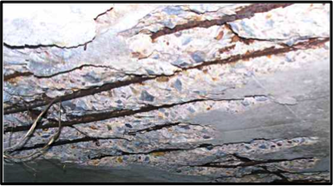What is Concrete Cancer?
When concrete is used in construction, it needs to be reinforced with steel in the form of bars or mesh. However, when exposed to air or water, steel corrodes, which causes it to expand.
The expansion of the steel causes the surrounding concrete to crack, and therefore undermine the strength of the building. The cracking or break down of the concrete is known as spalling. The cancer aspect is due to the progression of the corrosion of the steel spreading through the inside of the concrete.
Once the concrete cracks, it further exposes the steel to the atmosphere, and the process continues.
What causes concrete cancer?
The main cause of concrete cancer is poor quality concrete. This is particularly prevalent in older properties. Engineers nowadays tend to specify higher strength concrete & insist on greater quality control, although the following conditions can still contribute towards the problem:

- Harsh environment: In particular areas that are exposed to high levels of salt content in the air, such as coastal properties.
- Poor work practices: This may include incorrect placement of the reinforcement, leaving it exposed to weathering.
- Little or poor vibration of the concrete: This leaves air pockets in the structure, potentially increasing the likelihood of water retention & therefore damage.
- Earth movement: This causes the concrete to crack, allowing an area for moisture to attack the steel.
What should I do if I have concrete cancer in my home?
Act upon fixing it as quickly as possible. If the concrete cancer is readily identifiable then a structural engineer will have to determine the extent of the repairs. Once the affected areas are removed the engineer may specify sulphate resistant cement or galvanised steel reinforcement to reduce the likelihood of re-occurrence.
How can I reduce the risk?
Have regular inspections conducted on your property by a suitably qualified inspector, and if any cracking appears on your concrete surfaces seek professional advice.
